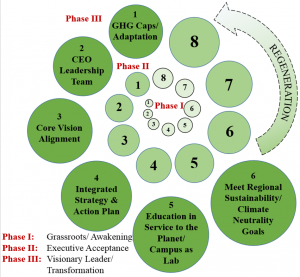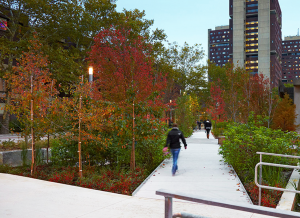After many years of hard work, we are excited to announce the launch of several new Green Campus Resources, available now on the UMass Campus Planning website.
 The LEED Buildings & Green Infrastructure page contains a list of all campus LEED buildings and sustainable infrastructure projects. Click each project to explore an overview, sustainable features, LEED statistics, a green building brochure, videos, and articles.
The LEED Buildings & Green Infrastructure page contains a list of all campus LEED buildings and sustainable infrastructure projects. Click each project to explore an overview, sustainable features, LEED statistics, a green building brochure, videos, and articles.
Campus Sustainability Maps offer new ways to view project statistics and energy consumption through an interactive, GIS interface.
The Sustainability Explorer provides information on campus sustainability initiatives. Projects fall under eight categories: advocacy, building, energy, food, landscape, recycling, transportation, and water. Zoom in and select an icon to view a description of each project and reveal additional information, including a project website, photos, and LEED scorecards. Zoom out to the campus boundary to view campus-wide projects.
 The Building Energy Explorer calculates and compares the Energy Use Intensity (EUI) for UMass buildings and associates this data with a map to visualize and analyze energy consumption across the campus. The application includes navigation icons, printing customization tools, background information options, layers, and a legend in the upper-right hand corner.
The Building Energy Explorer calculates and compares the Energy Use Intensity (EUI) for UMass buildings and associates this data with a map to visualize and analyze energy consumption across the campus. The application includes navigation icons, printing customization tools, background information options, layers, and a legend in the upper-right hand corner.
 The Frank A. Waugh Arboretum Map/Database and Campus Trees Database were developed by the arboretum to showcase the urban forest of the UMass campus and teach tree identification and appreciation.
The Frank A. Waugh Arboretum Map/Database and Campus Trees Database were developed by the arboretum to showcase the urban forest of the UMass campus and teach tree identification and appreciation.
Green Campus Policy Resources provide sustainability and energy conservation initiatives to campus staff, as well as designers and contractors working with the University.
· Green Building Guidelines v2 and LEEDv4 provide a framework for approaching new construction and major renovation projects at UMass Amherst that are undergoing LEED v4 certification by focusing the conversation on those green building aspects that are most important to the campus. They are intended to be the beginning of a dynamic conversation between designers, environmental consultants and constructors, university stakeholders, and users of new high performance buildings.
· Energy Modeling Guidelines were developed in 2015 as a resource on how to: i) generate energy models for campus buildings; ii) provide quality assurance review of current energy models; and iii) share UMass Amherst energy modeling input parameters with project design teams for them to establish a baseline building energy profile.
· The Building Measurement, Verification, Coordination and Template Plan was begun in 2013 and finalized in 2015 as a resource to project teams that undertake the measurement and verification of building systems during the first year of occupancy of a new building and renovation project, particularly projects undergoing LEED certification.
· Green Building Guidelines 2013 provide a framework for approaching new construction and major renovation projects at UMass Amherst that are undergoing LEED certification by focusing the conversation on green building aspects that are most important to the campus. They are intended to be the beginning of a dynamic conversation between designers, environmental consultants and constructors, university stakeholders, and users of new high performance buildings.
Please use these materials as a resource, and share them with friends, family, colleagues, and students. Go UMass!






